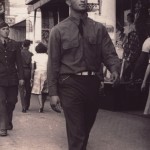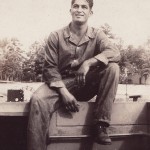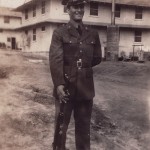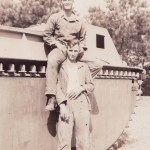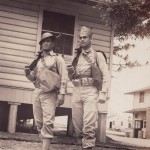Oral History Spotlight – Dominic Martello, 39th Infantry Regiment, 9th Infantry Division
Dominic Martello was born and raised in New Orleans, Louisiana, went to high school at Jesuit High School and upon graduation joined the New Orleans Fire Department. Martello never gave the Army much thought, as he says, “The average fella never thought he would be in a war until the draft came.” Drafted by the Army before Pearl Harbor, Dominic was assigned to the 39th Infantry Regiment of the 9th Infantry Division. Shortly after joining the 9th, he was shipped overseas for the initial landings in North Africa as part of Operation Torch.
The green US troops that landed between Algiers and Oran in November of 1942 had no idea what they were about to get into. The training that they had been given in the United States was not sufficient as Dominic recalls, “We needed all the training we could get. We were fighting professional soldiers and we were mostly civilians. These guys had been fighting in the desert for years. We were going to catch hell.”
Dominic was the driver for a halftrack that had 75mm howitzers mounted inside the vehicle to act as mobile artillery. Not long after landing in North Africa, Martello’s halftrack took a direct hit from a German 88mm artillery round, rendering it useless. With the loss of his vehicle, Martello fell in with the rest of the “dogfaces” of the 39th Infantry Regiment. As the North African campaign wore on, Martello’s unit slowly whittled down to a group of men that scarcely resembled their original state upon landing in November. By February at the Kasserine Pass, the heaviest weapon that his unit possessed was his Browning Automatic Rifle (B.A.R.).
Put at the edge of the Kasserine Pass in an effort to disrupt any German infantry attempting to infiltrate American lines, Martello and the rest of his unit were pounded by German artillery. As he puts it, “Those 88s were pretty close; you could hear them go by.” After the cessation of the artillery barrage, the German infantry attacked with a force that Dominic felt he could deal with, but the tanks that supported the German infantry were something that Dominic’s unit could not stop by any means. Martello recounts, “When you have a .30 caliber rifle and a tank is coming at you…you will not survive. The rifleman has no chance against an armored vehicle. When I saw those tanks coming…it’s a hard pill to swallow. How are you going to fight against a tank with a B.A.R.? There’s no way.”
The tanks and most of the infantry cut off Martello’s group. Constant machine gun fire kept the GIs pinned down. “I was in a cactus bush when they were shooting at me. That was the only place I could go. I figured I had better jump in there because I could get those cactus needles out of my behind a lot easier than that lead that they were shooting at me.”
That night Dominic’s group pulled out of their positions and attempted to escape the encirclement that had cut them off from their own lines earlier that day. The small band of GIs marched down a desert road and followed a German unit towardwhat they assumed were the American lines. Martello remembers, “It was so dark the Germans couldn’t tell if we were Americans or some of their guys.” The next morning, out of ammunition and more importantly, water, the small band of men were betrayed by native Arabs and captured by a German tank unit. The German officer in charge of the tank unit gave instructions to his men to shoot Martello and his comrades. However, the Germans refused. Dominic says of the incident, “I thought I was going to die right then.”
Dominic was captured at the Kasserine Pass in 1943 and spent 27 months in a German Prisoner of War Camp. When he was captured he weighed 200 pounds, but when he was liberated by US troops later in the war, he weighed a mere 87 pounds. Martello remembers, “We were so malnourished we couldn’t even walk.”
The war ended in 1945 but even now, the war still rages for Dominic Martello. “I’m back there, that’s my problem. Post Traumatic Stress, I was just back there. I can be driving my car and BAM…I’m there. I can be eating supper and BAM…I’m there…24 hours a day, seven days a week…all my life. I’m controlled by memories…I don’t want to be but I am.”
Dominic Martello was interviewed by Museum Historian Thomas Lofton in Martello’s home in Metairie, LA on August 28, 2008.
Find out more about Kasserine Pass on The National WWII Museum website.


